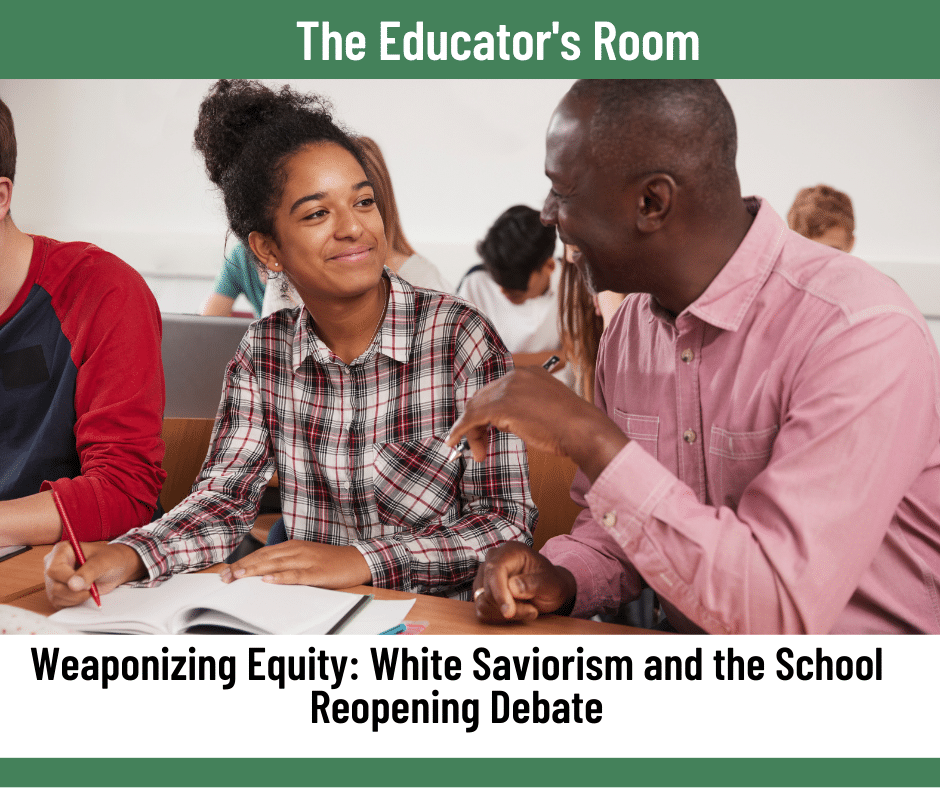Guest Writer: Kenny Ludlow
Kenny has worked in public schools for the past ten years in various capacities, and spent the past six years working as a classroom teacher. She has a passion for supporting and empowering other educators and currently works as a mentor for early career teachers in the Bay Area. She has a Masters in Education from Stanford University.
“Readers, many of us got involved in the Black Lives Matter marches last summer. Do Black lives matter to you only when they serve your political purpose? Shouldn’t we be marching to get Black and brown children back safely into schools right now?”
— David Brooks, Op-ed columnist for the New York Times (1/28/21)
“You got into this business for a reason, because you love to help people out… Teachers are the number one way to catch students for [Child Protective Services]… What they’re coming back from, we don’t know… We’re going to get them around people that will care about them the entire school year.”
— An Ohio principal, in a reopening speech to his staff, a quarter of whom have since tested positive for Covid-19
Since the start of the pandemic, the concept of equity and the language of social justice have been used to argue that schools should reopen for in-person learning. The argument, amplified in publications such as The New York Times and The Washington Post, is that distance learning worsens opportunity and achievement gaps for low-income and Black and Latinx students and that in-person learning is the more equitable option.
While distance learning is undeniably inequitable when it comes to access, resources, and support during distance learning, the devastation of this virus is inequitable as well. And it is becoming more and more clear that children play a more important role in the spread of this virus than was believed. It should be no surprise that, when surveyed, families of low-income and Black and Latinx students overwhelmingly support remaining in distance learning.
A recent CDC study showed that Black and Latinx parents were significantly more worried about the exposure risks of in-person learning than their white counterparts. Additionally, a study from the University of Texas revealed that 77% of Black families and 76% of Latinx families felt it was unsafe to send their children to schools, compared to just 42% of white families. Similarly, a majority of families who make less than $50,000 a year wanted schools to avoid in-person instruction entirely for the 2020-21 school year, while only 27% of families who make more than $150,000 a year wanted remote-only schooling, according to a USC study from July.
[bctt tweet=”Additionally, a study from the University of Texas revealed that 77% of Black families and 76% of Latinx families felt it was unsafe to send their children to schools, compared to just 42% of white families.” username=””]
Despite these studies, it is important to acknowledge that many parents and caregivers across races and social classes have been pushing for school buildings to reopen. And in the absence of real, meaningful government assistance, who could blame them? Working families bore an unfair burden, required to do their jobs, while also somehow homeschooling their children. Many families have been desperate for childcare, some have been concerned that their children might fall behind the grade-level standards without in-person instruction, and others simply crave a sense of normalcy during a challenging and chaotic time.
It is understandable for all parents, including white parents, to be angry, frustrated and stretched thin. But it is alarming to see white parents and caregivers employing terms like “equity” in supposed support of low-income and Black and Latinx students returning to school, when most of the families of those same students are saying clearly that they prefer distance learning. And while there are a lot of folks out there saying that schools are safe, the science points to schools being sites of community transmission, so it is equally alarming to see so many powerful pundits and politicians claim equity is a reason to return to in-person learning.
[bctt tweet=”But it is alarming to see white parents and caregivers employing terms like “equity” in supposed support of low-income and Black and Latinx students returning to school….” username=””]
In her recent New Yorker article, “Black America Has Reason to Question Authorities,” Keeanga-Yamahtta Taylor criticizes the often liberal return-to-school advocates for describing reopening as an equity issue, while ignoring the very real concerns of Black and Latinx parents who feel they must keep their kids home:
“It is as if Black and Latino parents, whose communities have borne the devastating brunt of this disease, need to be lectured about what constitutes equity for themselves or their children… In fact, it is the absence of equity that has driven these families to want to keep their children at home.”
When wealthy, mostly white parents, pundits, and politicians claim to speak for low-income and Black and Latinx families in the name of equity, as Taylor describes, but ignore what those communities actually want for their children, they are engaging in the dangerous tradition of White Saviorism.
The White Savior Industrial Complex, a term coined by Nigerian-American novelist Teju Cole, refers to a mindset that poor and/or Black people need “saving” by external forces while neglecting the roles white supremacy, settler colonialism, and capitalism have had in creating these conditions in the first place. The White Savior Industrial Complex is so deeply ingrained in our culture that it is reinforced in our history books (William H. Taft justifying colonialism in the Philippines by claiming to save our “little brown brothers”), our popular culture (celebrities taking pictures in Africa with Black babies as props), and the movies we consume (“nice white lady” characters “saving” non-white characters in movies like “Freedom Writers”). White Saviorism is rampant in the teaching profession, and so is the toxic martyrdom that accompanies it, which is why teachers who teach from their hospital beds make the news, while teachers who refuse to return to their unsafe workplaces for fear of spreading COVID in the community are reprimanded as selfish troublemakers.
On Monday, January 4th, 40% of Chicago Public Schools teachers and staff who were expected to report to schools on Monday for the first time during the pandemic didn’t show up to work. In a survey conducted by the Chicago Teachers Union, of the members who did return, almost 70% reported conditions that were “not adequate.” Staff concerns included buildings that were “filthy,” in “various states of disrepair,” and either having inadequate air purifiers or no air purifiers at all. When principals were surveyed by the Chicago Principals and Administrators Association, only 17% agreed that opening in January or February was the right decision. Consistent with data from the summer, the Chicago Teachers Union has also highlighted the fact that only one-third of Black and Latinx families and one-third of low-income families opted to return to classrooms, while two-thirds of white families chose to go back.
That last part is important. There are many dangers in White Saviorism, but in this case, liberal policymakers are harming the very population they claim to want to save. Prior to in-person instruction in Chicago, teachers offered virtual instruction to all students. Now teachers are being required to start “hybrid model” instruction, and their attention is split between their in-person students (disproportionately white) and their at-home students (disproportionately Black and Latinx), effectively taking teachers’ attention away from the very students that pundits and politicians have expressed so much concern about.
So what can white and/or wealthy caregivers, parents, pundits, and politicians do to avoid engaging in White Saviorism? How do we move from a place of saviorism to solidarity? When Teju Cole first wrote about the White Savior Industrial Complex, he highlighted the importance of digging deeper, and thinking about the underlying causes for the needs of those we deem less fortunate:
“[The White Savior] does not connect the dots or see the patterns of power behind the isolated “disasters.” All he sees are hungry mouths, and he, in his own advocacy-by-journalism way, is putting food in those mouths as fast as he can. All he sees is need, and he sees no need to reason out the need for the need.”
We can all agree that the inequities surrounding distance learning are a disaster. But what are what Cole calls the “patterns of power” behind the disaster? When we see the needs of students who are struggling with distance learning, how do we also see what Cole calls the “need for the need”? Rather than point to “equity” as a reason for in-person learning and risking spreading a virus that disproportionately harms communities of color, we should work toward eradicating inequity permanently– not just during the pandemic. We need to ask ourselves what systems of oppression have created the inequities we are seeing, and invest in a future without them.
And if we are white, wealthy, or in positions of power, let’s hear what the communities we have been speaking for actually want for their children. Are we listening? Or are we just picking and choosing which “equity” talking points fit in with our own agendas and self-interests? Maybe we are using “equity” and weaponizing the experiences of Black, Latinx, and low-income youth because it aligns with what we want personally. We must do better.
Editor’s Note: If you enjoyed this article, please become a Patreon supporter by clicking here.






